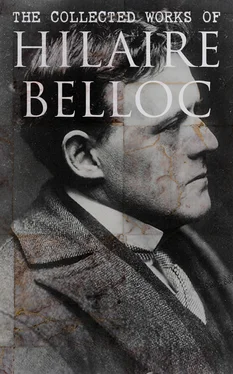It will be perceived that the plan upon either side was of a very simple sort, and one easily grasped. On the side of the allies it was little more than a “hammer-and-tongs” assault upon a difficult and well-guarded position; on the side of the French, little more than a defence of the same.
Next must be described the nature of the troops engaged in the various parts of the field.
Upon the side of the allies we have:—
On their left—that is, to the south of their lines and over against the wood of Lanière—one-third of the army under the Prince of Orange. The bulk of this body consisted in Dutch troops, of whom thirty-one battalions of infantry were present, and behind the infantry thus drawn up under the Dutch commander were his cavalry, instructed to keep out of range during the attack of the infantry upon the wood, and to charge and complete it when it should be successful. Embodied among these troops the British reader should note a corps of Highlanders, known as the Scottish Brigade. 12These did not form part of the British army, but were specially enrolled in the Dutch service. The cavalry of this left wing was under the command of the Prince of Hesse-Cassel, who was mentioned a few pages back in the advance upon Mons. It numbered somewhat over 10,000 sabres.
The other end of the allied position consisted in two great forces of infantry acting separately, and in the following fashion:—
First, a force under Schulemberg, which attacked the salient angle of the forest of Sars on its northern face, and another body attacking the other side of the same angle, to wit, its eastern face. In the first of these great masses, that under Schulemberg, there were no English troops. In strength it amounted alone to nearly 20,000 men. The second part, which was to attack the eastern face, was commanded by Lottum, and was only about half as strong, contained a certain small proportion of English.
It may be asked when once these two great bodies of the left and the right (each of which was to concern itself with one of the two woods in front of the gap) are disposed of, what remained to furnish the centre of the allies? To this the curious answer must be afforded that in the arrangements of the allies at Malplaquet no true centre existed. The battle must be regarded from their side as a battle fought by two isolated wings, left and right, and ending in a central attack composed of men drawn from either wing. If upon the following sketch map the section from A to B be regarded as the special province of the Dutch or left wing, and the section from C to D be regarded as the special province of the Austro-Prussian or right wing, then the mid-section between B and C has no large body of troops corresponding to it. When the time came for acting in that mid-section, the troops necessary for the work were drawn from either end of the line. There were, however, two elements in connection with this mid-section which must be considered.

First, a great battery of forty guns ready to support an attack upon the entrenchments of the gap, whenever that time should come; and secondly, far in the rear, about 6000 British troops under Lord Orkney were spread out and linked the massed right of the army to its massed left. One further corps must be mentioned. Quite separate from the rest of the army, and right away on the left on the French side of the forest of Sars, was the small isolated corps under Withers, which was to hold and embarrass the French rear near the group of farmsteads called La Folie, and when the forest of Sars was forced was to join hands with the successful assault of the Prussians and Austrians who should have forced it.
The general command of the left, including Lord Orkney’s battalions, also including (though tactically they formed part of the right wing) the force under Lottum, lay with the Duke of Marlborough. The command of the right—that is, Schulemberg and the cavalry behind him—lay with Prince Eugene.
The French line of defence is, from its simplicity, quite easy to describe. In the wood of Lanière, and in the open space just outside it, as far as the fields in front of Malplaquet village, were the troops under command of the French general D’Artagnan. Among the regiments holding this part was that of the Bourbonnais, the famous brigade of Navarre (the best in the service), and certain of the Swiss mercenaries. The last of this body on the left was formed by the French Guards. The entrenchments in the centre were held by the Irish Brigades of Lee and O’Brien, and by the German mercenaries and allies of Bavaria and Cologne. These guarded the redans which defended the left or northern part of the open gap. The remainder of this gap, right up to the forest of Sars, was held by Alsatians and by the Brigade of Laon, and the chief command in this part lay with Steckenberg. The forest of Sars was full of French troops, Picardy, the Marines, the Regiment of Champagne, and many others, with a strong reserve of similar troops just behind the wood. The cavalry of the army formed a long line behind this body of entrenched infantry; the Household Cavalry being on the right near the wood of Lanière, the Gens d’armes being in the centre, and the Carabiniers upon the left. These last stretched so far northward and westward as to come at last opposite to Withers.
* * * * *
Such was the disposition of the two armies when at half-past seven the sun pierced the mist and the first cannon-shots were exchanged. Marlborough and Eugene had decided that they would begin by pressing, as hard as might be, the assault upon the forest of Sars. When this assault should have proceeded for half an hour, the opposite end of the line, the left, under the Prince of Orange, 13should engage the French troops holding the wood of Lanière. It was expected that the forest of Sars would be forced early in the action; that the troops in the wood of Lanière would at least be held fast by the attack of the Prince of Orange, and that the weakened French centre could then be taken by assault with the use of the reserves, of Orkney’s men, and of detachments drawn from the two great masses upon the wings.
The reader may here pause to consider the excellence of this plan—very probably Marlborough’s own, and one the comparative ill-success of which was due to the unexpected power of resistance displayed by the French infantry upon that day.
It was wise to put the greater part of the force into a double attack upon the forest of Sars, for this forest, with its thick woods and heavy entrenchments, was at once the strongest part of the French position in its garnishing and artificial enforcement, yet weak in that the salient angle it presented was one that could not, from the thickness of the trees, be watched from any central point, as can the salient angle of a fortification. Lottum on the one side, Schulemberg on the other, were attacking forces numerically weaker than their own, and separate fronts which could not support each other under the pressure of the attack.
It was wise to engage the forces upon the French side opposite the allied left in the wood of Lanière half an hour after the assault had begun upon the forest of Sars, for it was legitimate to expect that at the end of that half hour the pressure upon the forest of Sars would begin to be felt by the French, and that they would call for troops from the right unless the right were very busily occupied at that moment.
Finally, it was wise not to burden the centre with any great body of troops until one of the two flanks should be pressed or broken, for the centre might, in this case, be compared to a funnel in which too great a body of troops would be caught at a disadvantage against the strong entrenchments which closed the mouth of the funnel. An historical discussion has arisen upon the true rôle of the left in this plan. The commander of the allies gave it out after the action (as we have seen above) that the left had only been intended to “feint.” The better conclusion is that they were intended to do their worst against the wood of Lanière, although of course this “worst” could not be expected to compare with the fundamental attack upon the forest of Sars, where all the chief forces of the battle were concentrated.
Читать дальше













